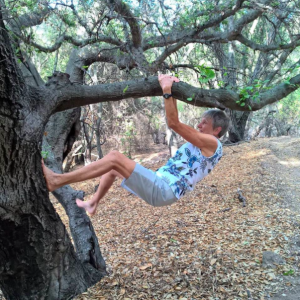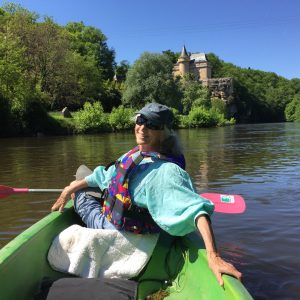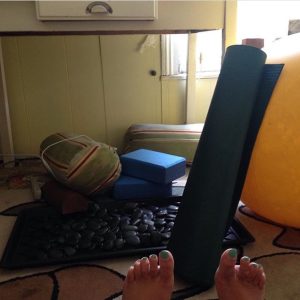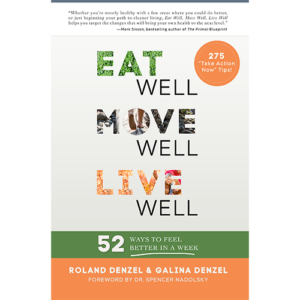We talked with Katy Bowman’s four co-authors of her forthcoming book Dynamic Aging: Joan Allen, age 78, Joyce Faber, 79, Lora Woods, 75, and Shelah Wilgus, 78.  Their stories, shared in more detail in the book, are seriously inspiring. (The book will be available in stores and online March 1… but pre-sale copies are available here.)
Their stories, shared in more detail in the book, are seriously inspiring. (The book will be available in stores and online March 1… but pre-sale copies are available here.)
We’re all told that we have to accept certain things as we age. These women, who have been working with Katy for nearly a decade each, are proof that just isn’t true. We’re not talking about climbing Mt. Everest at 80 (but if that kind of goal gets you moving, go for it!), we’re talking about having agency over our own bodies by way of understanding and appreciating how our bodies work. And, of course, working with ourselves as we age so that we can enjoy active, healthy lives that are filled with vitality and engagement for as long as each of us is roaming the earth.
JOAN began working with Katy at age 71 after a long career as an attorney (imagine the amount of sitting over the years). She’s dealt with pelvic prolapse, chronic constipation and foot problems. Joan, now 78, gleefully reports numerous changes to her overall health in the past seven years: her chronic constipation has disappeared, she walks daily, regularly hiking three to ten miles and can walk comfortably in zero-drop shoes and barefoot.
Scheduled for major surgery to address her pelvic organ prolapse at age 72, Joan was able to side-step that, continuing to heal her body through movement instead. Joan says, “My balance is the best it has ever been—two years ago I walked barefoot across a log six feet above a rushing river, something I never thought I’d be able to do, and certainly not for the first time at age 77. My overall body strength has improved significantly. Changing how I move has changed my life.”
We asked Joan: Is there a moment that stands out for you, a turning point in your work with Katy when you realized what kind of change was possible for you?
A: There have been many moments that stand out for me over the past seven plus years of working with Katy that I would consider turning points. One was when my chronic constipation ended after three to four years of diligently practicing the correctives, getting off my butt, and adding more daily movement to my life. Another was when I was able to discard my orthotics and once again walk barefoot on the beach and in minimal shoes with no discomfort. The ongoing “moment” or “turning point” for me is knowing what to do and doing it in the way of correctives and movements that have kept and are continuing to keep my pelvic prolapse under control.
Q: What are some of the physical accomplishments of which you’re most proud?
A: Overcoming my overwhelming fear of getting on the BOSU. Now I practice on the BOSU on both feet with my eyes closed, list on one leg, can list on the inverted BOSU and actually teach BOSU classes—all of which has helped enormously with my overall balance. The other physical accomplishment I am so proud of is climbing and hanging from trees. But for Katy, I never would have thought of doing something like this “at my age.” What freedom and exhilaration!
Q: What would you say to someone who’s thinking, well, that’s nice for you, but I don’t see how it could work for me?
A: Try it—you might like it. And, what have you got to lose? Whether you start Katy’s movement program or not, with any luck at all you will continue to accumulate more years. What if, like good wine, you could get better with age or at least not lose ground?
SHELAH started classes with Katy at age 66 after retiring from her graphic designer job (read: sitting at a computer. A lot). She describes herself as a “life-long exerciser,” and explains that it was the “logic of the scientific theory of Katy’s program” that convinced her to take Katy’s training program.
Shelah also describes herself as “a work in progress” and a product of her long-term habits. (Aren’t we all!) It was when she was preparing for a trip just before her 75th birthday that she reached into her closet for a garment and twisted too far. The resulting back pain, she says, was evidence that something was very wrong, and a later MRI confirmed she had serious scoliosis accompanied by painful shearing of lumbar vertebrae.
It was after a month of doctor-prescribed inactivity, aside from short walks on level ground, that she was well enough to start the basic exercises offered in Dynamic Aging. Shelah notes: “Moving better doesn’t automatically mean you don’t get injured, but it makes you more resilient if you do.” She credits Katy’s teaching with giving her “the knowledge and tools to know what movements I can do, like hanging and core strengthening, and which movements I must be very careful doing— like twisting.” And today at age 78, she can walk three to four miles daily in relative comfort.
We asked Shelah, what were your expectations, as you began studying with Katy?
A: I didn’t have any, but from the first class it was clear to me this was not a regular “exercise class.” I loved the clear explanation and theory of each movement, something I had never encountered in any other movement class.
Q: What else is on your physical bucket list?
A: Working on ribs down, feet straight ahead, and hanging (upper body strength.) I want to again be able to get up from the floor without using my hands, squat comfortably and do at least one pull up easily. And I would like to do some more long distance (10-20 miles a day) walking trips both in this country and abroad.
Q: What would you say to someone who’s thinking, well, that’s nice for you, but I don’t see how it could work for me?
A: Try it, what do you have to lose. It’s non-invasive and you are in control.
Q: What else would you like to say about the process of aging dynamically?
A: Be grateful and keep moving. Walking is (my) key to independence.
LORA was headed for the first of at least two surgeries that would have resulted in a complete knee replacement before she started to work with Katy. She says, “through my work as an RN and dance-movement therapist, I thought I knew and had experienced all the self-help modalities and was resigned to ‘the knife.’”
But after doing some of Katy’s exercises for two weeks, namely the calf stretches she learned, Lora began noticing that signs of her “restless leg,” which had robbed her of sleep for decades, had disappeared. It was that success, she says, that empowered her to cancel knee surgery and try more regularly the gentle knee-stretching exercises she’d learned from Katy for her frozen knee.
Now age 75, Lora can walk up to six miles at a time, which makes walking to all her in-town errands and appointments possible on what she refers to as her “original equipment.” She also says, “Incorporating the principles in this book into my daily activities has created opportunities to change life-long conditions I thought were just me.”
We asked Lora: Is there a moment that stands out for you, a turning point in your work with Katy when you realized what kind of change was possible for you?
A: I was skeptical but [engaging with the exercises fully]. The turning point for me—which I observed almost immediately—is that Katy has a completely different paradigm. This really works for those of us who want control in our lives. Early on in Katy’s program, I realized I had the power to change my projected future.
Q: What are some of the physical accomplishments of which you’re most proud?
A: I went on a Sierra Nevada packing/camping trip and faced eight miles mostly uphill the first day (that’s two miles more than I do without a 25-lb pack.) I got to the point of fatigue where I was shuffling and cursing myself for doing the trip. I considered my alternatives and found none, so I turned on my Katy-brain. I concentrated on rocking forward after each heel strike, and activating my toes in this way seemed to give me a little lift or boost. By the time one of my sons came back to find me I was well in control of the situation and he carried my pack for only about half a mile. And after that first day I needed no help!
Q: What would you say to someone who’s thinking, well, that’s nice for you, but I don’t see how it could work for me?
A: One success will lead you to many more. The power-of-the-body concept that Katy introduces you to is beyond expectation. So, one’s first success is rather like being set free of previously felt age limitations.
JOYCE navigated painful knee injuries for nearly 30 years; she tore the meniscus in one knee and the other knee was damaged shortly after from compensating stresses. Never enamored of the idea of surgery (skeptical it would bring actual improvement), Joyce leaned on various palliative measures over the years to mitigate her knee problems: limited walking, Tai Chi, gentle yoga stretching, daily pain medications, weekly chiropractic treatments, and massage therapy.
But when she started Katy’s program, she says, she began to understand her body for the first time from a biomechanical point of view and learned that injuries, pain, and inflammation are our bodies’ warning flags and that “we shouldn’t ignore them or power through them, but rather teach ourselves to heal using them as our guides.” She also says, “This whole-body model of wellness has taught me that our health is influenced more by our habits—the way we use, load, and live in our body—than by our age.”
 Joyce will turn 80 this year. She’s had no surgery, has regained her ability to walk without pain or impairment and, as she puts it, lives with wellness in her body, mind, and spirit. “Whole-body movement has made this possible in my life and I feel strong and capable walking the path to healing and wellness.”
Joyce will turn 80 this year. She’s had no surgery, has regained her ability to walk without pain or impairment and, as she puts it, lives with wellness in her body, mind, and spirit. “Whole-body movement has made this possible in my life and I feel strong and capable walking the path to healing and wellness.”
We asked Joyce: What were your expectations, as you began studying with Katy?
A: My expectation was that it would be just another version of Pilates, Yoga, or Tai Chi that I would need to learn yet again—another discipline and framework that would not give me any significant benefit. It seemed senseless and boring to me. I was not ready to choose surgery but did not have hope that there was another choice. I didn’t realize that there was a paradigm out there to heal the wear and tear on the body at the cause.
Q: Is there a moment that stands out for you, a turning point in your work with Katy when you realized what kind of change was possible for you?
A: Yes. I felt that excitement during the first lesson in her studio. Katy told about optimal cellular regeneration, how the body is a whole system affected everywhere by even the tiniest change. Doing the exercises with her was interesting for that reason and also because I felt aliveness inside and outside my body—and I realized that was important, very important to my health and well-being. Gaining that understanding was new and exciting to me—that how I learned to live in my body would directly affect my health.
Q: What are some of the physical accomplishments of which you’re most proud?
A: Walking effortlessly and aligned all day long! My car sits in the garage as I attend to my errands on foot each day, walking three to five miles or more. I gain my health directly from this habit. I’m most grateful to Katy for teaching me how to do this. I feel a sense of freedom, power and aliveness that is satisfying and connects me at a deep level to a vital source of my health.
Q: How would you describe your quality of life today?
A: Excellent, rich and fulfilling. Without Katy’s work, I would have had two knee operations, and one laminectomy for my cervical spine because of pain and loss of ability to move. My physical mobility would be compromised.


 It also happens to be a port visited by numerous cruise ships, mostly during the gorgeous fall we often get. And it was on one of those autumn mornings that I took the long way to work, through one of our city’s most expansive public parks, which leads down to the North Atlantic Ocean.
It also happens to be a port visited by numerous cruise ships, mostly during the gorgeous fall we often get. And it was on one of those autumn mornings that I took the long way to work, through one of our city’s most expansive public parks, which leads down to the North Atlantic Ocean. the signs for cars, the parking lot full of cars, and the fact that I was the only pedestrian around at that time. And in the background? A cruise ship that had—what was that?—a giant plastic giraffe on its upper deck, wearing a bright pink life preserver. And looking down to the other end of the upper deck, a huge, and I do mean huge, screen. Think Jumbotron you can see from miles away. At sea.
the signs for cars, the parking lot full of cars, and the fact that I was the only pedestrian around at that time. And in the background? A cruise ship that had—what was that?—a giant plastic giraffe on its upper deck, wearing a bright pink life preserver. And looking down to the other end of the upper deck, a huge, and I do mean huge, screen. Think Jumbotron you can see from miles away. At sea.
 First of all, the setting. Exquisite. We were so fortunate to be hosted by
First of all, the setting. Exquisite. We were so fortunate to be hosted by  Chef Kevin was entirely unfazed when I told him we wanted our guests to participate in some way in making the meal they were going to share with each other. In fact, this is the basis of what Chef Kevin does. So on the appointed day, he marshaled our eighty-or-so guests and got them working on cooking, assembling, and serving delicious appetizers, as cows milled around and the sun slanted across the hills. This act of making and serving food together turned our eighty guests into a cohesive group; fast friends were made, along with tasty bites!
Chef Kevin was entirely unfazed when I told him we wanted our guests to participate in some way in making the meal they were going to share with each other. In fact, this is the basis of what Chef Kevin does. So on the appointed day, he marshaled our eighty-or-so guests and got them working on cooking, assembling, and serving delicious appetizers, as cows milled around and the sun slanted across the hills. This act of making and serving food together turned our eighty guests into a cohesive group; fast friends were made, along with tasty bites! As the sun began to drift down toward the horizon, we raised our glasses and made a toast to water—“not just a condiment for your meal,” Katy said, “but the earth’s blood.” Water is life, we agreed, thinking of the WaterKeepers and all those at Standing Rock, and we savoured our water before the meal was served.
As the sun began to drift down toward the horizon, we raised our glasses and made a toast to water—“not just a condiment for your meal,” Katy said, “but the earth’s blood.” Water is life, we agreed, thinking of the WaterKeepers and all those at Standing Rock, and we savoured our water before the meal was served. We stood together in small groups, hot drink in one hand, handful of chocolate in the other, finishing conversations that had woven through the party, saying goodbye for now. A sweet end to a sweet evening. We are so grateful to everyone who worked to make our party a success, to everyone who made the journey to celebrate Movement Matters with us, and to everyone who took an interest from afar! Thank you!
We stood together in small groups, hot drink in one hand, handful of chocolate in the other, finishing conversations that had woven through the party, saying goodbye for now. A sweet end to a sweet evening. We are so grateful to everyone who worked to make our party a success, to everyone who made the journey to celebrate Movement Matters with us, and to everyone who took an interest from afar! Thank you! In the example the Denzels give, you make a simple slow cooker pork pot roast with vegetables, which gives you enough for Sunday night’s supper, and two more suppers later in the week. Just the words slow cooker pork pot roast make me want to hit the kitchen—and thinking about having three suppers done and dusted in one go fills me with glee. Chilly October nights seem like a perfect time to get into this habit.
In the example the Denzels give, you make a simple slow cooker pork pot roast with vegetables, which gives you enough for Sunday night’s supper, and two more suppers later in the week. Just the words slow cooker pork pot roast make me want to hit the kitchen—and thinking about having three suppers done and dusted in one go fills me with glee. Chilly October nights seem like a perfect time to get into this habit. I’ve been savoring that fresh fruit as it comes in, and doing my best to can and preserve as much as I am able for the long winter nights to come. And with the cooler temperatures here, both day and night, Galina’s advice to sip a sweet-tasting herbal tea like licorice or rooibos feels like exactly the right thing to do while I contemplate my relationship with sugar, and why I want to be in charge, rather than letting sugar run the show.
I’ve been savoring that fresh fruit as it comes in, and doing my best to can and preserve as much as I am able for the long winter nights to come. And with the cooler temperatures here, both day and night, Galina’s advice to sip a sweet-tasting herbal tea like licorice or rooibos feels like exactly the right thing to do while I contemplate my relationship with sugar, and why I want to be in charge, rather than letting sugar run the show. I concentrated on my gait as best I could, and then I just let my attention wander. I thought about the project I’m writing, and about the work awaiting me in the Propriometrics Press office. I returned to my desk feeling refreshed and nourished by my time outside, spent walking.
I concentrated on my gait as best I could, and then I just let my attention wander. I thought about the project I’m writing, and about the work awaiting me in the Propriometrics Press office. I returned to my desk feeling refreshed and nourished by my time outside, spent walking. His advice to keep a log of your daily time spent sitting was also world-rocking. I thought I was pretty dynamic—but there are always more ways to move.
His advice to keep a log of your daily time spent sitting was also world-rocking. I thought I was pretty dynamic—but there are always more ways to move. Behind the scenes here at Propriometrics Press we’ve been busy editing, proofing, designing, amending, editing some more, proofing some more, designing some more, proofing one more time and then finally sending off to press our forthcoming book Eat Well, Move Well, Live Well, by
Behind the scenes here at Propriometrics Press we’ve been busy editing, proofing, designing, amending, editing some more, proofing some more, designing some more, proofing one more time and then finally sending off to press our forthcoming book Eat Well, Move Well, Live Well, by 
